Over the last few years, I’ve been on a lot of podcasts (for a complete list, see here).
When I’m interviewed about freelancing and consulting, I inevitably get asked the following question:
If you could start over… with no network, no “name”, nothing. Just a laptop, and maybe $1,000 in seed money… what would you do?
Usually this question is asked within a rapid fire Q&A round, so I don’t get a lot of time to really flesh out an answer. Most of the podcasters are looking for sound bytes, and not necessarily comprehensive guides.
In this comprehensive guide I’m going to dedicate a few days of research and reflection instead of a few seconds, and attempt to give you a thorough framework for helping you build a freelancing business that won’t fail.
Who this guide is for: Full-time freelancers who want to shore up their business, those who have just begun (or are about to begin) running their freelancing business full-time, or anyone who’s thinking about it or wants to at least start doing side gigs.
Our plan of action
Here’s what I’m going to focusing on:
- Finding a network of people that we can influence
- Making it clear to this network that we can solve their problems
- Setting up processes that allow you to streamline the way you get stuff done and get new clients
- Expand your reach and land more referrals
This is, by far, the best and most proven way to build a services business from scratch. I’m going to be as thorough as I can in laying out exactly what I would do and why I’d do it.
This guide is also systematic. It’s meant to be followed from start-to-finish. It’s intended to be actionable — that is, you should walk away from this guide with a todo list.
Working now vs. Working later
Everyone reading this guide is at a different stage in their business.
You might be just starting out. No clients. No name. You’ve got a full-time job. You want to get that first client, but you really don’t necessarily need a client right away (after all, you still have a paycheck).
But you might have left your job already, and you need work to stay afloat. You need work now, because you’re burning through your savings and/or the bills are piling up.
When preparing my course, Sell Yourself Online: The Blueprint, I identified a handful of Client Acquisition Channels:
- Job boards
- Marketplaces or exchanges, like oDesk/Upwork, Elance, and Freelancer.com
- Subcontracting through agencies
- RFPs
- Cold contacting
- Networking events and conferences
- Referrals
- Paid acquisition
- Business seminars
- Content marketing / social media (I’d include open source work, etc. in this channel)
- “Feeder” products (ebooks, training, software)
These are all launch points that can bring new contacts and work your way, but the ones in bold are more immediately gratifying.
Projects that are listed on job boards, freelancer marketplaces, or sent to you as an RFP typically know what they need done, have a budget (or at least have the beginnings of one), and are more-or-less ready to go.
Ditto for subcontracting. Agencies have projects that are already signed and need people to help them with it.
Cold contacting, as a method of pitching somebody on the spot, puts a potential project in front of some business. While it’s not always the easiest method of getting work (and, for many of us, the most uncomfortable), it can work. It’s ultimately a numbers game, albeit one that typically requires a lot of time invested. An example of a cold contacting strategy that works can be found in my guide on selling to ecommerce clients.
The rest of the Client Acquisition Channels yield better projects, but they tend to take longer. Again, depending on your current needs you’re going to want to consider whether you want to compete on publicly listed projects or subcontract for other people’s businesses.
But the primary focus of this guide, namely the way you’ll create a freelance business that’s sustainable, is to focus on the longer term, more valuable projects, and to systematize how you acquire them.
Here are the channels we’ll be focusing on in this guide:
- Building your audience by networking.
- Increasing the reach and quality of your audience through content marketing and possibly seminars.
- Getting more referrals by tapping into your audience.
Step 1: Borrow other people’s audiences
When I had my local agency, our audience started with 0 people in it.
This is the starting list size for everyone. But by being consistent and doing the right things again and again, that number grows. We eventually had a few dozen people in our local audience. And then a few hundred. And then a few thousand. At the time of writing this guide, the audience size for my new business (DoubleYourFreelancing.com) is over 50,000. It started at zero.
Since I’m focused on helping you build a sustainable business from scratch, I’m going to assume you have no audience. You have no particular influence outside of friends or family, and maybe a few peers or past clients.
Your first step is to find other people who have already done the hard work for you — people with pre-existing audiences.
Every city has groups that provide networking and support to local business owners. The type of people involved in these groups varies greatly: real estate agents, financial planners, accountants, attorneys, CEOs, and salespeople. We’re not concerned with finding a high signal-to-noise ratio. We’re just looking to get more people to know about you and what you do at this point.
A few places you should start:
- Your local Chamber of Commerce
- Your local BNI chapter
- Meetup.com
- Eventbrite
Google for the following:
- [your city] + “events”
- [your city] + “networking”
- [your city] + “entrepreneur”
- [your city] + “business”
Often times, your local newspaper (especially a business newspaper, should your area have one) is a great way to find upcoming events.
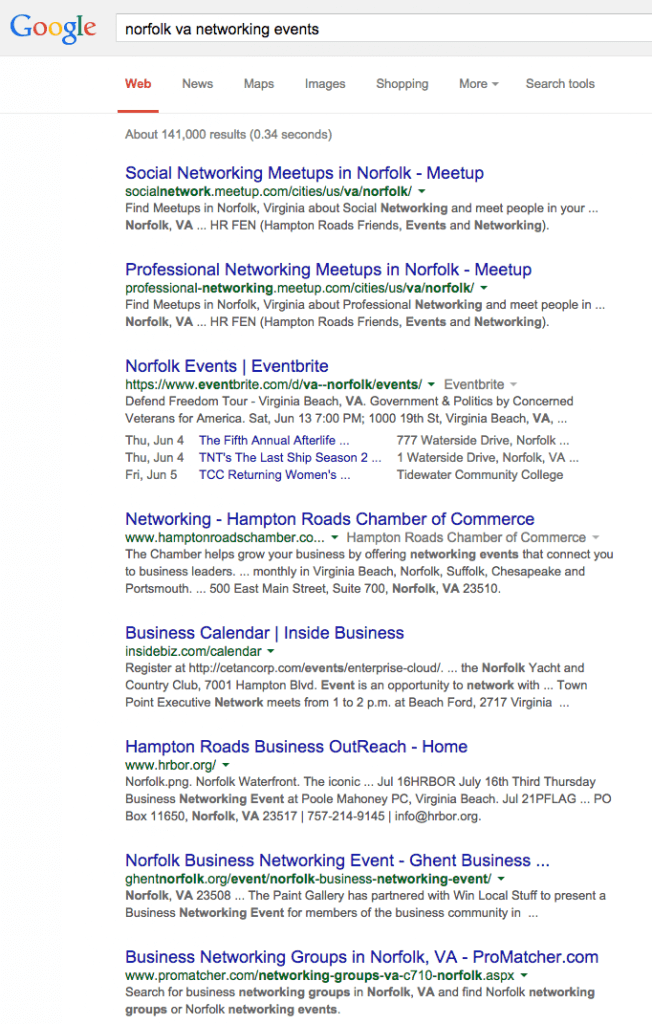
Once you’ve singled out a few events, or sites that list local events, you want to find one or two future events that you can attend.
Again, don’t worry about the title of the event, who it’s intended for, what the topic (if any) is about, or whatever else. I live in a city called Chesapeake, but that wouldn’t keep me from going to the Norfolk Business Networking Event.
You’re going to meet new people to add to your audience, and not to find clients. (This is important.)
Once you’ve figured out what events you’re going to be attending, you want to learn as much as you can about who’s in charge.
What do they do?
Who do they work for?
What other things are they involved with?
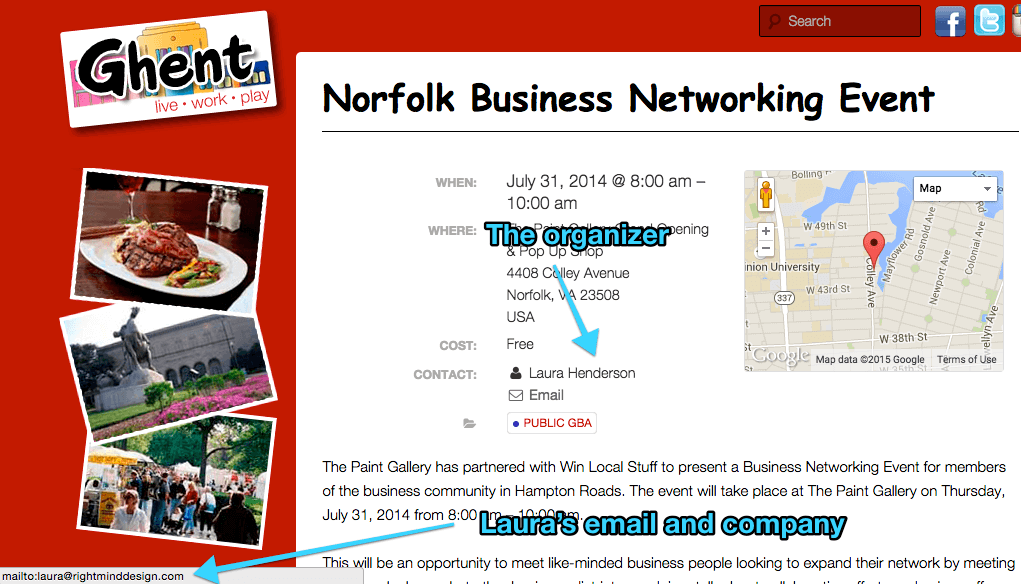
When you’ve figured out who the organizer is, use your Google-fu to find their LinkedIn profile, website, Facebook page, or whatever else.
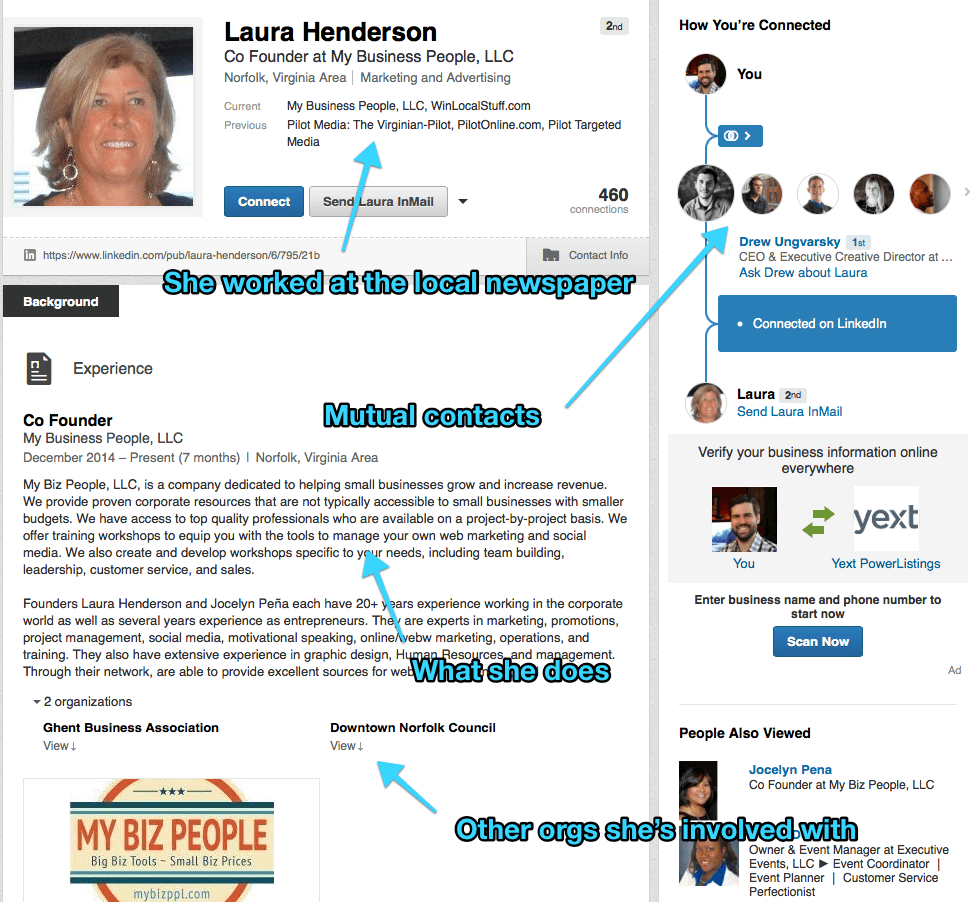
It’s important to figure out who’s running the event, and a bit about them.
They know people. They know their audience. And there’s probably nothing they like better than introducing their new friend (you!) to other attendees at the event.
The organizers put a lot of time into these events, and by showing that you’ve “done your homework” you’re going to make a very strong, and very favorable impression. At this point, there’s no one more important in the room to you than the organizer. She’s going to be interested in what you do, and will want to matchmake you with people who she thinks aligns well with you and your business.
I’ve found that by walking into a new event prepared, and with an understanding of who’s in charge, what they do, and why they do what they do, I’m immediately put on the organizer’s “Good List.” This is going to prove really valuable in the future.
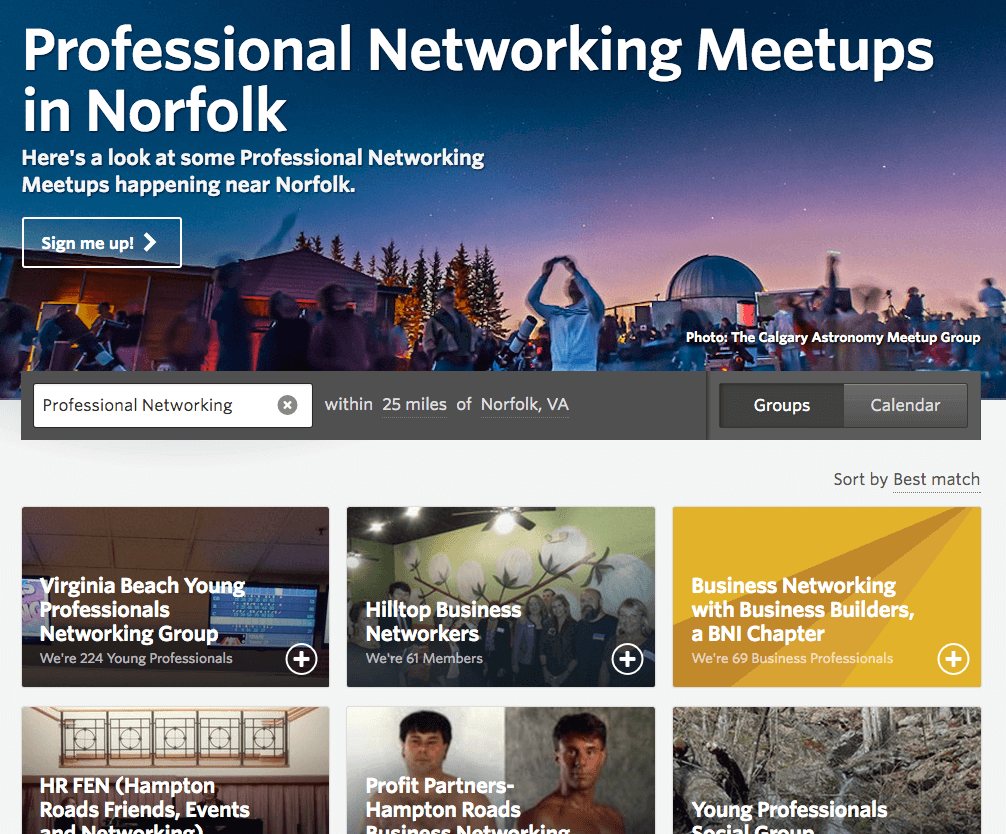
Websites like Meetup.com not only list upcoming events in your area, but also show you who’s RSVPed for events. You can do a limited version of the research we did for the organizer for each attendee. Does anyone stand out? Is your dream client going to be there?
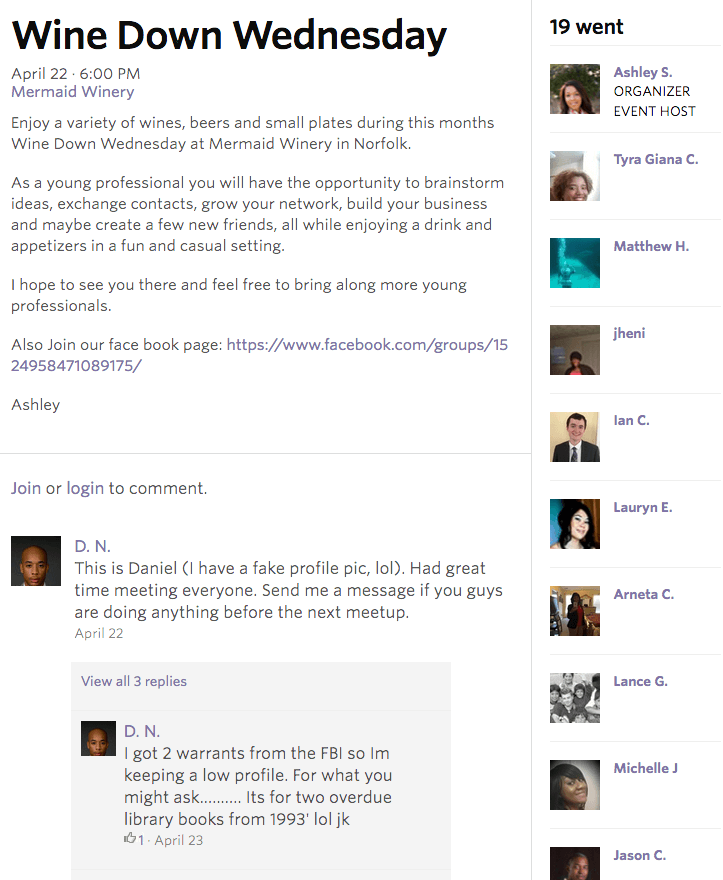
When attending a networking event, the last thing you want to do is sell.
You’re not there to land a new client.
Those fluent in the networking circle know that type, and treat them as an anathema.
Remember: You’re there to expand your network and to build your audience.
You’re going to do this by doing a lot of listening, and providing off-the-cuff value to people where it makes sense. Here’s how I recommend you “work the room.”
In the next section, we’re going to talk about how you stay in touch and nurture the connections you’ll have made, but there’s one more thing I want you to do first…
You know you should be blogging, right?
But you probably don’t know what you should write about (I’ll cover what you should be writing later on in this guide). You should absolutely review the event you went to, especially if you hit it off well with the organizer.
Write a summary about where it was, how many people were there, any big takeaways you got from it (either from a formal presentation or just discussions you had with attendees), and what your action steps are as a result of the event.
This will REALLY impress the organizer. And it will have the added side benefit of creating an additional piece of content that can work on your behalf and serve as an organic acquisition point for local entrepreneurs who are Googling around for events like the one you attended.
So what’s the big deal with impressing the organizer?
Why am I so gung-ho on getting you to learn about who they are and forming a strong connection with you?
They’re going to be one of your primary advocates. They know the local business community, and send referrals to people they like. On top of that, you’re going to want to eventually cash in on the relationship you have with them by pitching them on letting you host a business seminar in front of their audience.
I get a lot of cold pitches from people I don’t know. Whether it’s from people who have products or services that target freelancers, or just somebody who wants me to use my reach to promote them. 99% of these requests get shot down. It’s not because I don’t want people to succeed — it’s ultimately because I don’t want to diminish what I have spent so much time and effort to build up between me and my audience.
But I’m a lot more willing to hear out and help out my friends. The same is true of local influencers. They’ll help you if they like you, and this is a straightforward way to get them to shower you with favor.
Step 2: Keep in touch
You’ve probably walked away with a small stack of business cards. And if you followed my guide on hacking networking, you have implicit opt-ins from people who want to get more value from you in the future.
What you don’t want to do is followup with open-ended requests to meet. “We should get coffee sometime” isn’t something that makes anyone rush to their calendar and block out time to meet with you.
Rather, you want to create a few solid next steps for your new relationships. (We’ll talk about creating processes around this in the next section.)
Stephen,
I wanted to shoot you a quick note to say that I really enjoyed meeting you last night.
It’s really impressive to see what you’re doing over at , especially around [something you learned about them].
I occasionally write and curate articles about how businesses like can tap into technical trends to grow their bottom lines. If you don’t mind, I’ll email you from time to time with some information that I think you’ll really get a lot out of. (If you’re not interested, just reply and let me know.)
Hope you’re off to a great start of your day. I’m about to kick start a new client project – wish me luck! 🙂
-Brennan
OK, so let’s deconstruct the above email.
First, I talked about him. I enjoyed meeting him and I’m really impressed with what he and his company are working on.
Next, I told him that I want to send him free, no-strings-attached info that can help his business grow.
Lastly, I hinted at the fact that I consult.
See what I did?
- Create relevancy. Find a way to tie in something that you discussed or learned about.
- Give THEM something. In this case, occasional advice and info about how to grow their business.
- Remind them that you do this stuff for a living, even if it’s done subtly.
You’re not yet ready to try to sell somebody on anything. You’re just looking to establish yourself as an authority in your space.
Congratulations. You now have a newsletter and a captive audience (even if it’s just 1 person for now). Over time, your audience will start to slowly expand. Remember: We all start from 0.
So what do you write about?
How do you continue to drip value to your audience?
Here’s what I recommend as a baseline:
- Create a list of interesting articles that you come across online
We often forget that our clients aren’t us. They don’t read what we do, and they’re not as interested in our field as we are. That’s understandable; the reverse holds true too.Each month, you should compile a list of good articles that fit squarely between what you technically do and what your clients are typically interested in.
An example might be Neil Patel’s recent post on blogging for primarily offline businesses. I know that the majority of people who attend my local business networking events don’t read Neil’s blog, but are probably pretty interested in knowing how online marketing can affect their offline business.
And rather than just blasting out a bunch of links, you want to analyze each article.
What did you get out of it?
How do you think it will help the reader and their business?
Is there anything within it that your reader should really focus on?
But what if they try to do what Neil’s recommending?! I want them to hire me!
This is a common, but often unwarranted, objection to “giving away the farm” (many of my students are initially reluctant to host a seminar because they’re worried that if they tell people what they do, these people will sidestep hiring them altogether).
You don’t want Do-It-Yourself’ers. You want pragmatic clients who don’t have the time or the knowhow to do it on their own.
- Send a monthly newsletter to your audience with this curated list of links and takeaways (bonus points if you include your own articles) This doesn’t need to be fancy. In fact, you could even start by just BCCing your handful of audience members. Compile your list of links into a nicely packaged email newsletter.Here’s an example:
This month, I wanted to share with you some articles that I found. When you have a chance, give them a read, and don’t forget to send me your action steps (see my note at the bottom of this email)
How To Use A Blog To Drive Customers To Your Offline Business by Neil Patel
Many of my clients, along with the businesses I meet with each week here in Norfolk, struggle to find ways to bridge the online with their offline business. These businesses know they need to market themselves, and a lot of them end up hiring pricey marketing managers to write loads of content and shamelessly share what they’ve written over-and-over on social networks.The problem lies with who’s reading.
In his article, Neil Patel lays out a very solid overview of how predominantly offline businesses should think about not only creating content, but putting it in front of the right reader — ideally, a target customer. I’ve found this true with my own clients… many of them come to me with plenty of past content on their blog, but with few results to show for it all.
…
I’m letting other people create the content (like Neil), but I’m weighing in with my own thoughts and opinions and also tying it into the work I do.
Unlike many newsletters, which have the writer screaming BUY. BUY. BUY., this format lends itself to making it clear that you’re active in your industry, are intelligently able to weigh in and exert your own authority and expertise on certain subjects, and pops that authority and expertise on a monthly basis in front of your audience.
And because you’re writing for your audience and not yourself, they’re going to become conditioned to receiving value from you. This is vital.
- Kick off conversations around the content you share At the end of your newsletter, you should have a call-to-action that encourages the reader to do something.Since you’re sending your audience actionable articles along with your takeaways, you should be asking readers what major takeaways and to-dos they personally received from the content you shared.Once they have these, your goal is to get them to email you with them. Here’s why:You want your audience to self-discover that they have a problem that can be solved, and you want to position yourself as the best person to do that. This call-to-action is meant to help you kick off a conversation, which hopefully leads into a sales meeting.If somebody reads Neil’s article and comes away with thinking that they’ve been doing a poor job at online marketing, you want them to share this with you along with what their next steps are. They might not know their next steps at this point, but you want them to have a lightbulb moment or two each month.
Here’s where you (let’s say you’re a freelancer marketer) can come in and prescribe what you would do in their shoes.
And don’t be afraid to let them know that this is exactly what you do for your clients for a living, and would love to help them fulfill this prescription.
What ends up usually happening is this “I’m sick, I’ve figured out what I need, and I need a doctor” process happens independently of us. By the time we’re brought, say, a website redesign project, the client has already determined that they have an issue, it can probably be solved, and the way to solve it is by redesigning their website.
You want to be central in helping them come up with these problems, and you want to set yourself up as the best person to solve their problem(s).
This strategy of creating valuable content on a recurring basis and sending it to your audience is the single best way to generate high quality leads from scratch. You’re not backing people into a corner and screaming, “YOU REALLY NEED A NEW WEBSITE!” Instead, you’re letting them come to that realization through the content you’re sharing, and serve as the best, most trusted, and most capable candidate for their business.
Step 3: Create processes – and stick to them
Hopefully this approach has so far made a lot of sense.
We’ve primarily focused on building your audience, one conversation at a time, and then delivering value to your audience constantly and consistently.
In order to really make sure this gets done, it’s important to schedule your time.
Trust me when I say it’s really easy to get lost in client work. We tend to want to work in our business, rather than on our business, because when we’re working in it we get paid. You work an hour today, and you get paid for that hour on your next invoice.
That becomes a problem when you run out of client work.
So since we’re on a path to building a sustainable freelance business, we need to earmark our time for marketing and relationship building.
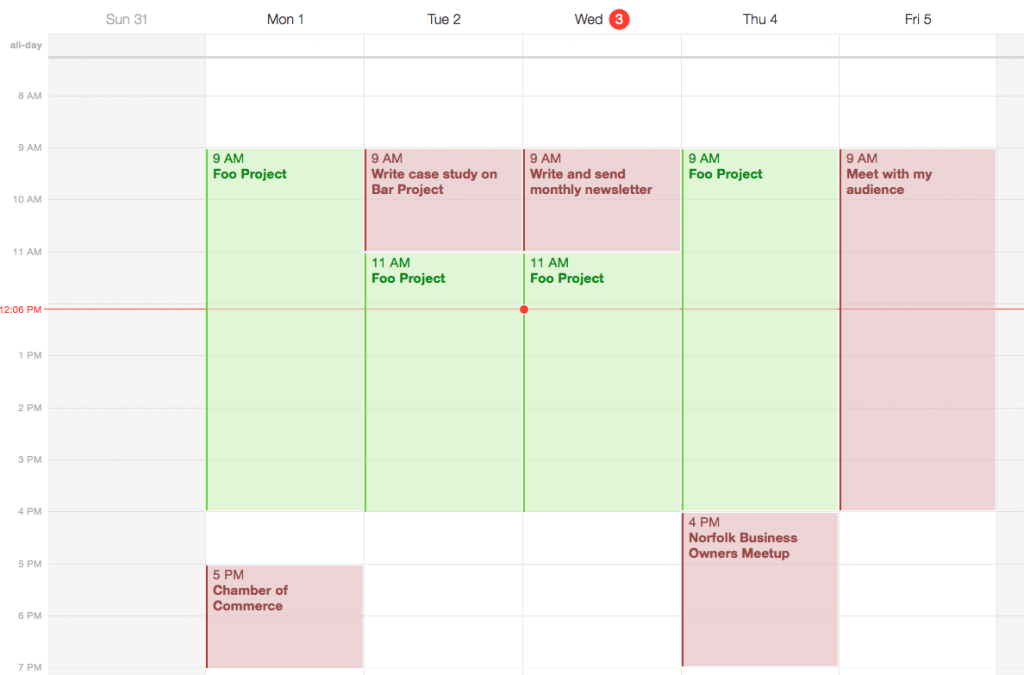
Examples of things that involve you working IN your business:
- Working for clients (duh!)
- Meetings with clients
- Invoicing
- Bookkeeping
- Writing proposals
And tasks associated with working ON your business:
- Networking
- Meeting with your audience
- Hosting seminars or webinars
- Writing blog posts
- Recording podcasts
- Guest blogging
- Writing your newsletter
- Fine tuning your marketing automation
Working on your business usually takes the backseat, because the payoff isn’t immediate – if ever.
“I’ll write a blog post… someday.”
The best way for that blog post to get written is to schedule it. It’s important to set aside the time each week for doing the things that will keep your business in business a year from now, along with what’s keeping you in business today.
And don’t trust yourself to do the work that’s valuable over the long haul. Schedule yourself. Plan your weeks. As Tim Ferris would say, opt for a Choice-Minimal Lifestyle.
You need to get serious about your business. As a freelancer, you won’t be freelancing (that is, doing client work) full-time. That’s not how you stay in business, or create a sustainable and healthy business. You need to make time to shore up how you market and sell yourself, and make growing your audience a priority.
You should have processes that relate to just about everything you do. This will not only minimize the number of decisions you need to make, but it will go a long way in impressing your clients with your professionalism.
At a minimum, you should have processes in place for:
- Qualifying new leads
- Structuring sales meetings
- Writing proposals
- Onboarding new clients
- Communicating updates and soliciting feedback from active clients
- Offboarding clients
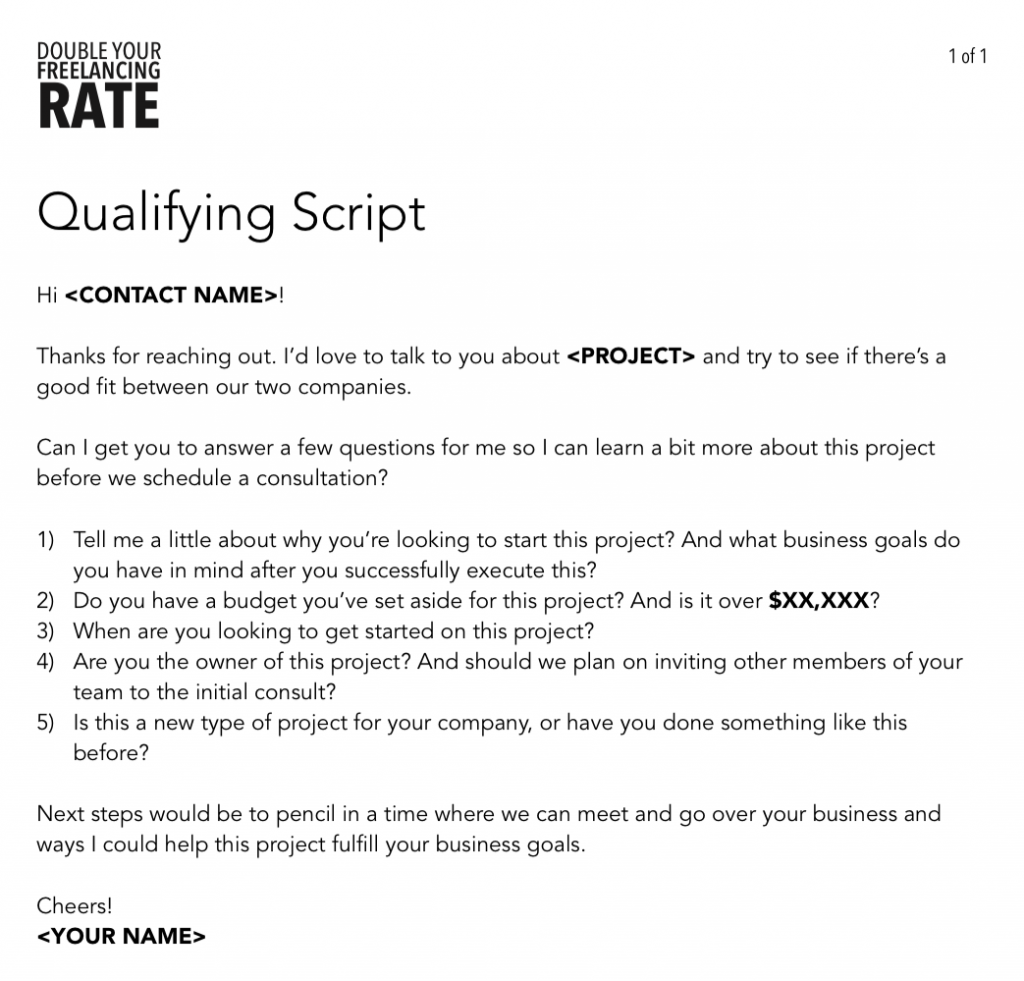
Additionally, you should have marketing processes in place:
- New audience member followup
- Newsletter compilation and sending
- How you create case studies / blog posts / etc
- Soliciting referrals from past clients
These processes should usually take the form of checklists or copy templates that you can reuse. By creating processes and procedures for accomplishing key tasks in your business, you’re effectively “productizing” your business. You’re creating a repeatable product that’s easier to market and sell. Your clients see you as a lower risk because it’s obvious you’ve done all this before.
Ultimately (and this outside of the scope of this guide), this will help you create a niche for your business and assist you in refining your audience, your message to them, and what you do to serve a more focused, and more repeatable, shared problem.
Step 4: Use the right tools
If you’re going to be running your own freelancing business, you’re inevitably going to surround yourself with tools that help you get things done.
It’s easy to get obsessive about our tools. Many of us think that by using or buying a particular tool, that we’ve made some huge leap forward in our business. Not so. A tool is just a means to an end, and should either make us look better to our clients (= make us more money) or automate manual processes (= save us more time).
Proposal software I recommend: Bidsketch
Invoicing software I recommend: Freshbooks
Project management software I recommend: Client Portal or Basecamp
Email / marketing automation software: ConvertKit
Time tracking software: Noko
At a minimum, the software you use should make your life easier. Ideally, it also helps you increase your professionalism and the amount of money you make.
Grouped in tools, I’d also recommend you get an accountant and find a bookkeeper (or use services like Bench). You’re also going to need to have a master services agreement and statement of work contracts in place once you sign your first clients. You can piece together the legal documents you need by searching online, and Double Your Freelancing Rate can provide you with all the documents you’ll need.
Step 5: Expand your reach
You now have everything you need to set yourself up with a profitable and sustainable freelancing business.
You know how to build an audience, which you can expand over time by hosting your own events, paying for traffic, guest blogging, going on podcasts, and more.
You also know how to provide value to your audience, and include call-to-actions that can kick off sales discussions.
You also have a baseline understanding of how to run your business, and have a list of tools that can help you get paid, manage your projects, and so on.
The final part of this guide is on expanding your reach.
Most of us get referrals from past clients of ours.
This constrains our referral base. We’re limited by the number of people we’ve worked with, which when you’re just starting out can mean that your referrals are severely limited — or non-existant.
Let’s look at what makes past clients willing to refer you…
- They’ve received something of value from you (that is, the project(s) you did for them).
- They thought you did a solid job at it, both in what you delivered and how you engaged with them.
- They’re OK with risking their reputation by referring you to others.
The big thing I want you to focus on here is that they’ve received something of value from you.
This is exactly why we want to build an audience and continuously and constantly push value their way!
It’s great when someone from your audience comes up with a problem and budgets for it, but it’s far more likely that your audience, your army, will be your best referral sources — and not the best source of clients for you.
Your sphere of influence is now no longer limited to clients who you’ve worked with, who can only grow as quickly as you can work.
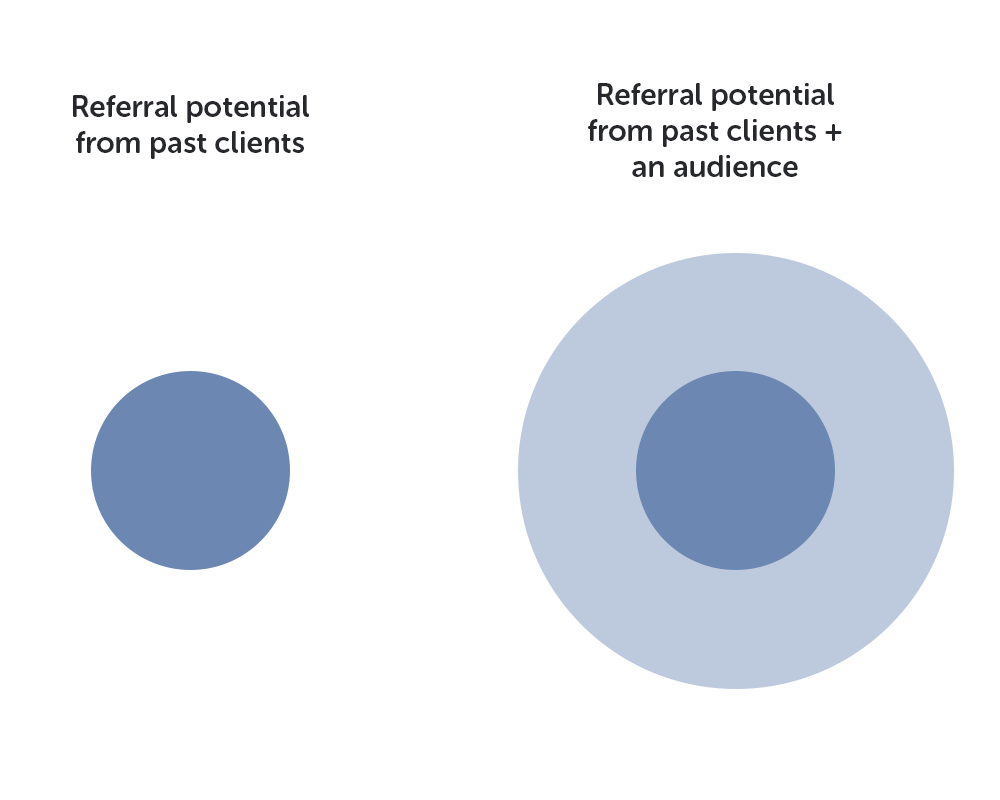
Your sphere of influence is now expanded to include Laura, the event organizer, who loved the blog post review of her event you wrote. Your sphere also includes everyone you’ve met at events who’s been silently consuming your content for months now. And it even includes those on the periphery, those who were forwarded copies of the emails you sent to your list or have heard about the value that you’ve been delivering to your audience.
This dramatically increases your referral base.
The #1 reason freelancers fail is because they get comfortable with the fact that they have clients now, and haven’t done anything to prepare for the future. They don’t have a marketing system in place that acquires new audience members, conditions them, and ultimately allows their audience to either 1) hire them or 2) refer work their way.
As my business grew, and we had hundreds — and then thousands — of audience members. We had a surplus of referral work. We were able to book our team of 11 out for months. We had systematized our sales and marketing.
Even if you’re running solo, the very same rules apply. And you don’t need hundreds or thousands of audience members — you can start with just a handful. Over time, more people will:
- Understand that you have something important to offer
- Recognize you as an authority in your subject
- Know that you can apply that expertise to other people’s problems (for example, theirs)
This is how you build a business that will last for years to come.
This is how you start a freelancing business that won’t fail.
Expert opinions
I reached out to a few friends of mine that hang out in a chatroom with me (many of whom will be speaking at or attending my upcoming conference) to get their thoughts on building a sustainable freelancing business. Here’s what they had to say:
I used to spend so much time creating custom proposals for projects of all shapes and sizes. Now I create offerings to match the most common client needs, and people can take or leave them. The result: clients know what they’re getting, I can develop a track record on my past performance, I gain a reputation for a certain activity, and I don’t have to constantly pitch others on the value of my work. It’s less stressful and more lucrative, with better clients.
– Nick Disabato
Earlier in my career, I would treat every prospect as a potential “whale” and every project as my only chance ever to land and eat that whale (I think doing a bit of agency work trained me to think this way). Since then I’ve realized that it’s often better to think in terms of the smallest possible increment of improvement I can make for that client and propose that. The client and I can always ride the wave of success from a small, successful project into more ambitious engagements in the future. So this is another way to deal with the trust issue that is at the heart of selling your services. Build it in little increments.
– Philip Morgan
The single greatest “authority hack” I’ve found is speaking. Any form of content marketing that involves prospects _listening to the sound of your voice_ is going to have huge impact. The trick is “trade up the chain.” Your local Chamber of Commerce and other organizations would love to have an expert speaker come in for free and educate their members or the community. (Don’t worry, you only need to know 10% more than your audience to look like expert.) Here’s the best part: once you’ve done one speaking gig, you’ll find yourself invited to more and even better gigs. You can trade up from local gigs to podcasts to conferences to television very rapidly. I wish I had standard operating procedures in place for booking gigs from day 1.
– Kurt Elster
Getting on the phone with prospects as early on as possible has made a night and day change in how often we land projects. But it also exercises our consulting muscles. We get better and become more confident at being able to problem solve and respond to clients in real time, which really pushes us to level up what we do.
– Michael Steele
People talk about Calls to Action (CTAs) all the time on the web, but they apply just as much to communicating with leads and clients. I used to end emails with phrases like “let me know what you think” or “let me know if you’d like to proceed with this project” (insert facepalm.jpg here). Now, I try to end every communication with a lead or client with a clear, concise CTA: “Do you want to proceed as proposed? If so, please pay the attached invoice and I’ll get you on our schedule.” This does two things: 1) it makes it extremely clear what needs to happen next, and 2) inserts a sense of urgency and exclusivity – the only way to get on the schedule is to pay the invoice.
– Travis Northcutt
When I first started consulting, I was afraid that every client that I signed was the only client I’d have, so I was more than willing to change scope and suffer late payment for the chance to continue working together. I treated each client like a unique and rare prize. Now, I realize that _I’m_ the prize and that there is an abundance of clients for me to work with. If a prospect doesn’t feel like a fit, I’m comfortable recommending that they work with someone else. And if a client relationship changes, I know that there are hundreds of prospects out there to work with — because I’ve built an audience that values my insight and expertise in solving their expensive problem.
– Kai Davis
It’s kind of cliched, but: Follow your passions. Obviously, this is advice everyone can’t follow, but if you are fortunate enough to be in a position to spend your time on things you love and obsess over, do it! Working on things that energize you instead of drain you can be the deciding factor that makes or breaks your business. Being passionate about your work is a great way to help you focus your positioning, which leads to becoming an expert and increasing your luck surface area.
– Zack Gilbert
One last thing…
It’s important to know what you need to charge in order to hit your annual income goal. Check out my free email course that can help you figure out exactly what you should be charging, along with some suggestions on how to get there.